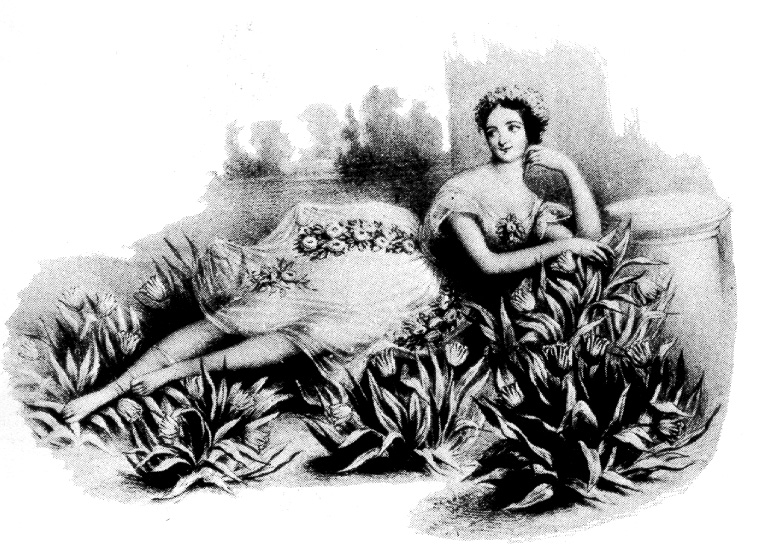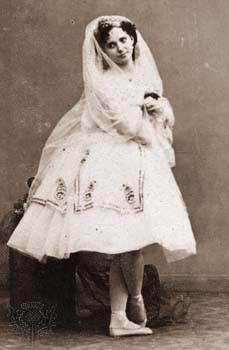
Texts / Biographies
 |
MARIE TAGLIONI Stockholm 1804 - Marseille 1884
|
A biography of Marie Taglioni
Marie Taglioni, was an Italian ballerina, choreographer and ballet teacher. She is considered the first
master of pointe dancing, was the first “star” of romantic ballet and was already a myth during her lifetime.
Her real name was Mariana Sophie Taglioni, born on 23 April 1804 in Stockholm, Sweden, died 22 April
1884 in Marseille, France. She is also called Marie Taglioni the Elder to distinguish her from her niece of
the same name. Actually the Marie Taglioni Polka by Johann Strauss Sohn is dedicated to Marie Taglioni
the Younger (1833-1891).
She belonged to a well-known dynasty of dancers and choreographers that included, among others, her
grandfather Carlo Taglioni, her uncle Salvatore, her cousin Louise, her father Filippo Taglioni, her brother
Paul and her niece Marie Taglioni the Younger. Marie Taglioni's mother, Hedvig Sophia Karsten (1783-
1862) was the daughter of a Swedish opera singer.
Marie grew up in Kassel and Paris. She received training in Paris from Jean-François Coulon, the same
who had taught her father. Under the supervision of her father Filippo, who in a sense made her a living
instrument and the muse of his choreographic creations, she had to undergo a rigorous regime of technical
exercises very advanced for that time. When Filippo Taglioni was engaged in Vienna between 1819 and
1824, he had her debut on 10 June 1822 as the nymph Delia in his Anacreontic Divertissement at the
Kärntnertortheater. She later danced in Munich and from 1825 to 1827 in Stuttgart.
On 23 July 1827, she made her debut at the Paris Opera in a pas-de-deux created by Filippo in the ballet Le
sicilien, ou L'Amour peintre (after Molière) by Anatole Petit. She celebrated triumphs in the role created for
her as Bajadère in the opéra ballet Le Dieu et la Bayadère by Scribe and Auber, as well as in the famous
“nun ballet” in Meyerbeer's opera Robert le Diable (1831). Her innovative dance style, invented for her by
her father, emphasized her seemingly disembodied lightness and her ethereal, graceful nature - which
actually hid strength and extraordinary balance acquired through iron training - and was endlessly admired
by her contemporaries.
She made her London debut in 1829; in the same year the composer Hector Berlioz wrote (in Paris):
“Mademoiselle Taglioni is not a dancer, she is a spirit of the air, she is Ariel personified, a daughter of
heaven.” She finally entered the annals of ballet history when she caused a sensation at the Paris Opera in
1832 - and shortly afterwards also at Covent Garden in London - in the ballet La Sylphide by Jean
Schneitzhoeffer as an ethereal, fragile spiritual being. Her father had devised a choreography for her in
which she largely seemed to float weightlessly across the stage on pointes or stood on one foot in an
arabesque, something that had never been seen before. La Sylphide is considered the true beginning of the
romantic ballet, and Taglioni's interpretation earned her veneration, even idolization, and lasting fame
during her lifetime.
The fascination of her dance lay not only in its cold technical perfection, but also in its special poetry and
grace. As an example, the poet and ballet enthusiast Théophile Gautier described Marie Taglioni as: “one of
the greatest poets of our era; (...) she is not a dancer, but the dance itself.” On the other hand, Taglioni was
considered the embodiment of purity, innocence and chastity, in contrast to the earthly-seeming sensuality of
dancers like Lise Noblet or especially Fanny Elssler, who were highlighted as a counter-image to her,
especially at the Paris Opera.
On 18 September 1832, Taglioni married Jean-Pierre-Victor-Alfred Gilbert de Voisins (1800-1863) in
London, with whom she had two children: Marie (1836-1901) married to Alexander Troubetzkoy (1813-
1889) and Georges-Philippe (1843-1893) married to Sozonga Ralli (died 1906 in Paris). Her husband is said
to have been a spendthrift who literally "threw her money out the window", and she divorced him in 1844.
Marie Taglioni continued to dance the main roles in all of her father's ballets, which she helped to achieve
success, including La fille du Danube (The Danube's Daughter; 1836), La gitana (The Gypsy; 1838), and
L'ombre (The Shadow; 1839), Satanella (1842) and La Péri (1843). Between 1837 and 1842 she performed
every winter in Saint Petersburg and during this time she also toured to Vienna (1839-1840), Warsaw
(1840), Stockholm (1841) and London (1839-1845). Taglioni quickly became an ideal and a role model for
younger dancers, who took on her roles without being able to challenge her for her generally recognized
leading position. This was reflected even in Jules Perrot's choreography of the divertissement Pas de quatre
to the music of Pugni, premiered in London in 1845, where Taglioni danced at the helm of three other
leading ballerinas - Fanny Cerrito, Carlotta Grisi and Lucile Grahn; A similar Pas des Déesses (Dance of the
Goddesses) followed in 1846 with Taglioni, Cerrito and Grahn.
From 1841 to 1846, further art tours took her to Italian theaters in Milan, Trieste, Vicenza, Bologna and
Rome, and she was celebrated there as a “true star of Italian dance” and as “Queen of Dance”. Her career
was coming to an end; she had her last appearance on 21 August 1847 in London in the ballet Le jugement
de Pâris (The Judgment of Paris) by Jules Perrot and Cesare Pugni.
She retired to Blevio on Lake Como before working in Paris from 1858 to 1870 as a teacher at the ballet
school of the Paris Opera. There she created the choreography for Jacques Offenbach's ballet Le Papillon in
1860 for the dancer Emma Livry, who she sponsored. Another ballet by Taglioni called Zara, with libretto
by Charles Nuitter, was not performed due to Livry's tragic death.
From 1871 to 1880 Marie Taglioni lived in London and continued to give ballet lessons. She spent the last
years of her life with her son in Marseille.